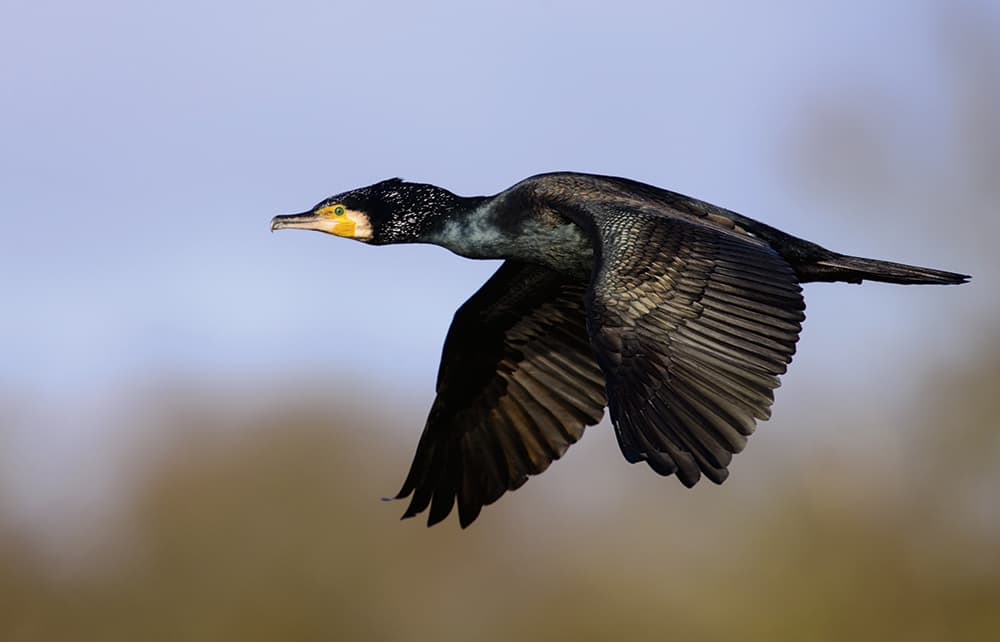About cormorants
Cormorants are present across most of the UK during winter, and make ideal subjects for photography with their iridescent and glossy black plumage. They provide plenty of opportunities for a wide variety of images, including the much-desired shots of them with fish in their beaks.
- Location In winter cormorants can be found across most of the UK; breeding birds are mostly found close to the coast, although increasingly they also breed inland.
- Size 70-102cm; wingspan 121-160cm.
- Nests Made of seaweed or twigs, built in trees or on cliffs. Diet A wide variety of fish.
- Population 9,000 breeding pairs, 41,000 wintering individuals.
Cormorants are widespread, large, and often show surprising tolerance to humans, making them good photographic subjects. At this time of the year, adult birds show white feathering on their heads, making them particularly photogenic.
Habitat
During the winter, cormorants can be found inland at large bodies of water including lakes, reservoirs and wetlands, perched conspicuously on branches or other objects with their wings outstretched to dry them. They feed exclusively on fish, which they catch by diving beneath the surface of the water.
To stand the best chance of photographing these birds it’s a good idea to sit and observe them for a while. That way you can work out if they have any favourite perches, and get to know their preferred fishing locations. Once you’ve got this information you can stake these areas out.
Best time to shoot
At this time of the year the sun is low in the sky, so you don’t have to worry too much about harsh shadows and highlights, and the accompanied loss of detail that can make shooting in the summer months challenging. However, early morning and late afternoon still coincide with periods of the greatest activity for most birds, and the light can have a lovely quality at these times. Shooting at either end of the day provides opportunities to experiment with silhouettes against the water, and backlit images really stand out from the crowd.

As this cormorant flew past me, the sun caught its plumage revealing an iridescent dark-green colour on its neck.
Shooting advice
Settings
As with all wildlife, I use continuous autofocus, my fastest frame rate (4 frames per second on my D800) and single spot focus. I use aperture priority or manual mode depending on the situation. If the light is consistent, manual mode is a good option, but if the sun is going in and out behind the clouds aperture priority gives me one less thing to worry about. It’s also important that the camera’s metering is not confused by the dark colour of the bird’s plumage.
Finding them
Diving birds make excellent photographic subjects, because you can often approach them while they are still underwater, which allows you to get quite close. Just make sure that you keep still and try to be as inconspicuous as possible when they surface. Once you are near enough to photograph them, get as low to the ground as you can – this often results in a diffuse foreground and background allowing the bird to stand out in the frame.
Approach
The range of images you can take is extremely diverse – you can capture cormorants drying their wings, swimming, or flying, but it’s the shots of them fishing that I love the most. By watching them feed you can capture them with their prey in their mouths, as well as moments when they surface from dives, with water running off their face.

I had actually been photographing something else on this occasion, but when this cormorant came up with a pike my focus quickly changed!
Kit list
Telephoto lens
A lens of at least 300mm is normally required to photograph cormorants as, like most wildlife, they do not come as close as you might like. A long lens also blurs out the background, emphasising the subject.
Binoculars
I always keep a pair of binoculars with me when I’m out shooting. They are much brighter than looking through a camera lens, making it easier to spot your subject. They also weigh significantly less.
Oscar Dewhurst is an award-winning wildlife photographer from London currently studying at Durham University. Most of his pictures are taken around his home city, but he has also spent time in other locations including the Peruvian rainforest. www.oscardewhurst.com







